Stewart J. College Algebra: Concepts and Contexts
Подождите немного. Документ загружается.

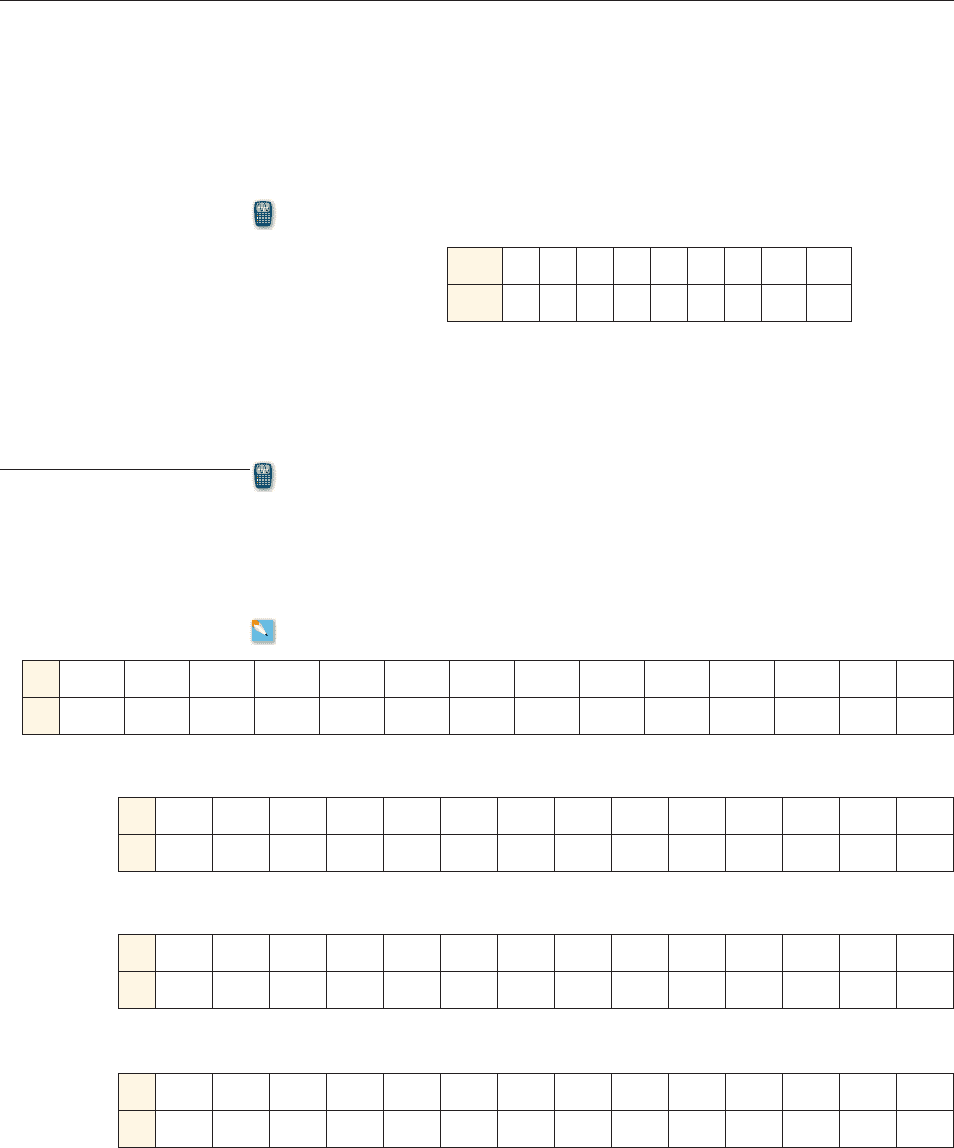
464 CHAPTER 5
■
Quadratic Functions and Models
5.5 Exercises
CONCEPTS
Fundamentals
1. When modeling data we make a _____________ plot to help us visually determine
whether a line or some other curve is appropriate for modeling the data.
2. If the y-values of a set of data increase and then decrease, then a _____________
function may be appropriate to model the data.
Think About It
3–4 ■ The following data are obtained from the function .f 1x 2= 1x - 32
2
x 0.1 0.8 0.8 1.2 1.7 2.3 2.6 3.1 3.3 3.4 3.9 4.1 5.2 5.9
y 101.2 106.7 105.2 110.1 112.7 114.6 113.3 113.1 109.1 110.4 109.2 107.1 97.6 95.5
x 0.2 0.3 0.9 1.4 1.5 1.8 2.4 2.6 3.9 4.1 4.7 5.2 5.5 6.3
y 37.8 41.7 45.8 46.2 48.1 49.9 47.3 45.1 42.4 36.2 32.5 29.3 27.9 21.8
x 0 1 2 3 4 5 6 7 8
f 1x 2
9 4 1 0 1 4 9 16 25
3. If you use your calculator to find the quadratic function that best fits the data, what
function would you expect to get? Try it.
4. Find the line of best fit for this data. Graph the line and a scatter plot of the data on the
same screen. How well does “the line of best fit” fit the data?
5–8
■ A set of data is given.
(a) Make a scatter plot of the data. Is it appropriate to model the data by a quadratic
function?
(b) Use a graphing calculator to find the quadratic model that best fits the data. Draw a
graph of the model.
(c) Use the model to predict the value of y when x is 7.
5.
SKILLS
7.
6.
x 0.5 0.7 1.3 1.9 2.3 2.8 2.9 3.3 3.7 4.1 4.1 4.4 4.9 5.5
y 52.1 48.2 45.3 40.8 39.7 35.5 34.1 32.5 31.2 32.7 33.4 36.1 38.3 41.2
8.
x 0.0 0.2 0.7 1.2 1.2 2.1 2.9 3.1 3.5 3.7 4.2 4.3 5.5 6.1
y 13.1 12.2 10.1 9.2 9.6 8.7 8.6 9.1 10.7 10.9 11.8 13.4 16.9 18.2
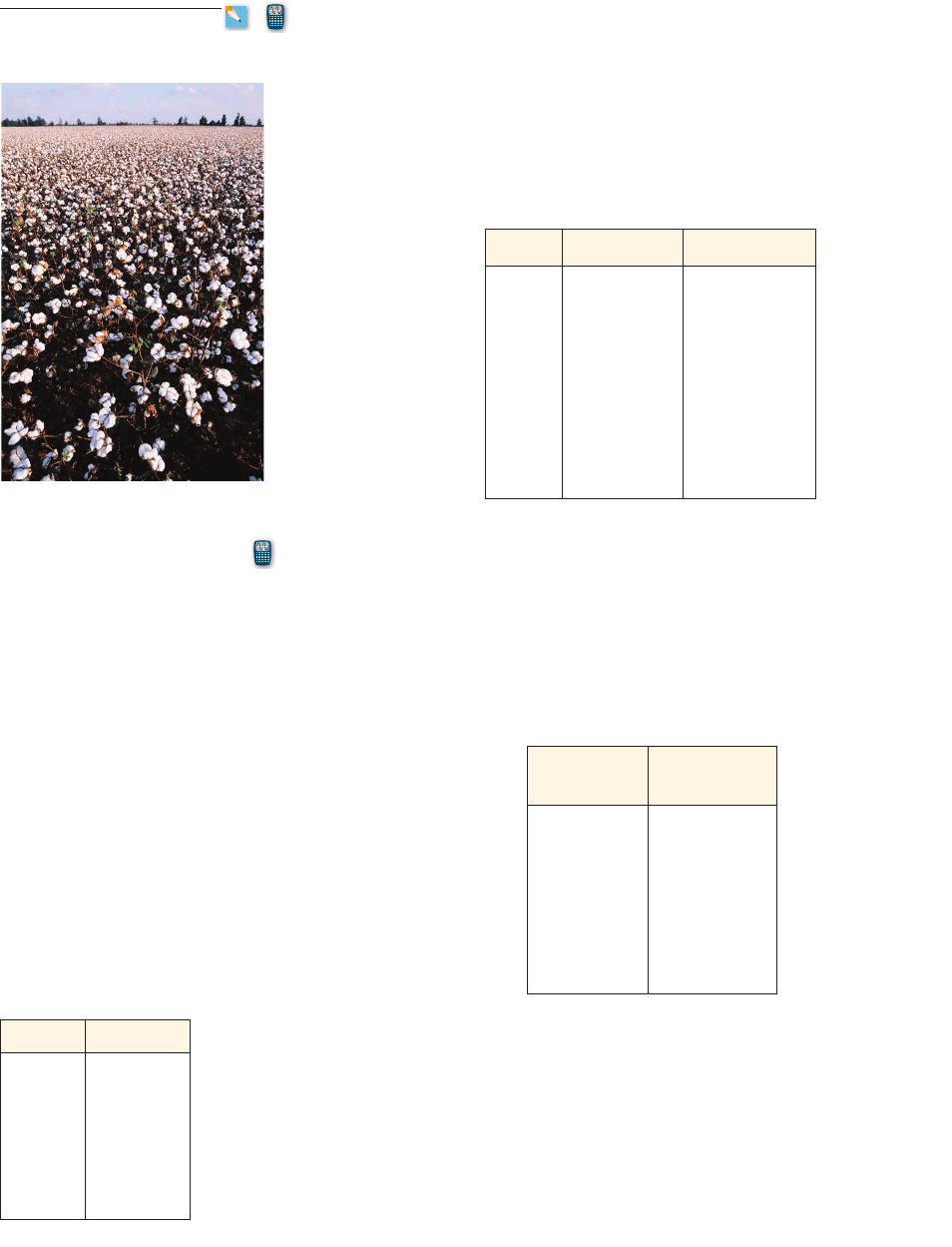
SECTION 5.5
■
Fitting Quadratic Curves to Data 465
10. Too Many Corn Plants per Acre? The more corn a farmer plants per acre, the greater
is the yield the farmer can expect—but only up to a point. Too many plants per acre can
cause overcrowding and decrease yields. The data give crop yields per acre for various
densities of corn plantings, as found by researchers at a university test farm.
(a) Use a graphing calculator to find the quadratic model that best fits the data.
(b) Draw a graph of the model you found together with a scatter plot of the data.
(c) Use the model that you found to estimate the yield for 37,000 plants per acre.
9. Rainfall and Crop Yield Rain is essential for crops to grow, but too much rain can
diminish crop yields. The data give rainfall and cotton yield per acre for several seasons
in a certain county.
(a) Make a scatter plot of the data. Does a quadratic function seem appropriate for
modeling the data?
(b) Use a graphing calculator to find the quadratic model that best fits the data. Draw a
graph of the model.
(c) Use the model that you found to estimate the yield if there are 25 inches of rainfall.
CONTEXTS
Season Rainfall (in.) Yield (kg/acre)
1 23.3 5311
2 20.1 4382
3 18.1 3950
4 12.5 3137
5 30.9 5113
6 33.6 4814
7 35.8 3540
8 15.5 3850
9 27.6 5071
10 34.5 3881
Ted Wood/Getty Images
Density
(plants/acre)
Crop yield
(bushels/acre)
15,000 43
20,000 98
25,000 118
30,000 140
35,000 142
40,000 122
45,000 93
50,000 67
11. Height of a Baseball A baseball is thrown upward, and its height is measured at
0.5-second intervals using a strobe light. The resulting data are given in the table.
(a) Make a scatter plot of the data. Does a quadratic function seem appropriate for
modeling the data?
(b) Use a graphing calculator to find the quadratic model that best fits the data. Draw a
graph of the model on the scatter plot of the data.
(c) Find the times when the ball is 6 meters above the ground.
(d) What is the maximum height attained by the ball?
Time (s) Height (m)
0.0 1.28
0.5 7.96
1.0 12.22
1.5 14.02
2.0 13.38
2.5 10.27
3.0 4.82

466 CHAPTER 5
■
Quadratic Functions and Models
12. Torricelli’s Law Water in a tank will flow out of a small hole in the bottom faster
when the tank is nearly full than when it is nearly empty. According to Torricelli’s Law,
the height of water remaining at time t is a quadratic function of t. A certain tank is
filled with water and allowed to drain. The height of the water is measured at different
times as shown in the table.
(a) Use a graphing calculator to find the quadratic model that best fits the data.
(b) Draw a graph of the model, together with a scatter plot of the data.
(c) Use the model that you found to estimate how long it takes for the tank to drain
completely.
h1t 2
Time (min) Height (ft)
0 5.0
4 3.1
8 1.9
12 0.8
16 0.2
CHAPTER 5 REVIEW
CONCEPT CHECK
Make sure you understand each of the ideas and concepts that you learned in this chapter,
as detailed below section by section. If you need to review any of these ideas, reread the
appropriate section, paying special attention to the examples.
5.1 Working with Functions: Shifting and Stretching
Shifting Graphs Up and Down If , then:
■
To graph , shift the graph of upward by c units.
■
To graph , shift the graph of downward by c units.
Shifting Graphs Left and Right If , then:
■
To graph , shift the graph of to the left by c units.
■
To graph , shift the graph of to the right by c units.
Stretching and Shrinking Graphs Vertically To graph :
■
If , stretch the graph of vertically by a factor of c.
■
If , shrink the graph of vertically by a factor of c.
Reflecting Graphs
■
To graph , reflect the graph of in the x-axis.
■
To graph , reflect the graph of in the y-axis.
5.2 Quadratic Functions and Their Graphs
A squaring function is a function of the form , where .
A quadratic function is a function that has been derived from a squaring func-
tion by applying one or more of the transformations described in Section 5.1.
Every quadratic function can be described in either of the following forms:
■
General form: , where
■
Standard form: , where a 0f 1x 2= a1x - h 2
2
+ k
a 0f 1x 2= ax
2
+ bx + c
C 0f 1x 2= Cx
2
y = f 1x2y = f 1- x2
y = f 1x2y =-f 1x 2
y = f 1x20 6 c 6 1
y = f 1x2c 7 1
y = cf 1x2
y = f 1x2y = f 1x - c 2
y = f 1x2y = f 1x + c 2
c 7 0
y = f 1x2y = f 1x 2- c
y = f 1x2y = f 1x 2+ c
c 7 0
CHAPTER 5
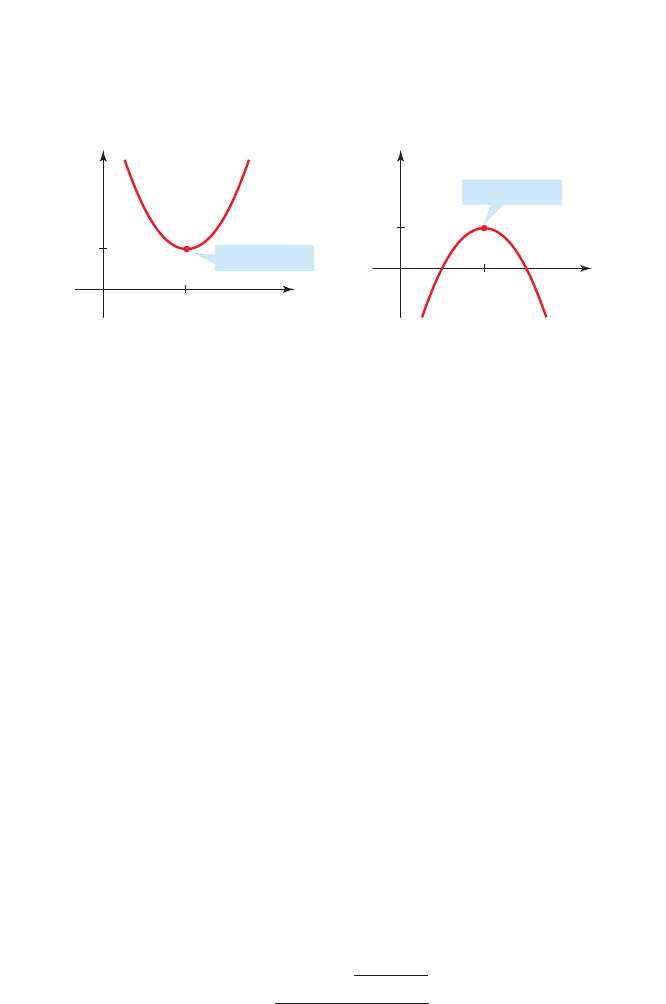
CHAPTER 5
■
Review 467
A quadratic function written in general form can be expressed in standard form by
completing the square.
The graph of a quadratic function is most easily obtained from the standard
form. The graph of is a parabola with vertex (h, k); it opens
upward if and downward if .a 6 0a 7 0
f 1x2= a1x - h 2
2
+ k
y
x
0
Ï=a(x-h)™+k, a>0
y
x
0
Ï=a(x-h)™+k, a<0
h
k
h
Vertex (h, k)
Vertex (h, k)
k
5.3 Maxima and Minima: Getting Information from a Model
If a quadratic function is given in standard form , then we have
the following:
■
If , then f has the minimum value at the vertex of its graph.
■
If , then f has the maximum value at the vertex of its graph.
If a quadratic function is given in general form , then its mini-
mum or maximum value occurs at .
■
If , then f has the minimum value .
■
If , then f has the maximum value .
5.4 Quadratic Equations: Getting Information from a Model
To get information from a quadratic model, we often need to solve a quadratic
equation, which is an equation of the form
To solve a quadratic equation, we use one of the two following methods:
■
Factoring: If the left-hand side of the equation factors readily, factor it, set
each factor equal to zero, and solve the resulting simpler equations.
■
Quadratic formula: If factoring is not practical, use the Quadratic Formula
The discriminant D of a quadratic equation is the number that appears inside the
square root in the quadratic formula, that is, .
■
If , then the equation has two distinct real solutions.
■
If , then the equation has exactly one real solution.
■
If , then the equation has no real solutions.D 6 0
D = 0
D 7 0
D = b
2
- 4ac
x =
- b ; 2b
2
- 4ac
2a
ax
2
+ bx + c = 0
f 1- b>12a22a 6 0
f 1- b>12a22a 7 0
x =-b>12a2
f 1x2= ax
2
+ bx + c
f 1h2= ka 6 0
f 1h2= ka 7 0
f 1x2= a1x - h 2
2
+ k

468 CHAPTER 5
■
Quadratic Functions and Models
REVIEW EXERCISES
1–6 ■ Sketch the graph of f. Then use shifting, stretching, and/or reflecting to sketch the
graph of on the same axes.
1. 2.
3. 4.
5. 6.
7–10
■ Sketch the graph of the function, not by plotting points, but by starting with the
graph of a basic function and applying transformations.
7. 8.
9. 10.
11–12
■ A quadratic function is given.
(a) Express the function in general form.
(b) Express the function in standard form.
(c) Find the x- and y-intercepts of its graph.
11. 12.
13–18
■ A quadratic function in general form is given.
(a) Express the function in standard form.
(b) What is the vertex of the graph of the function?
(c) Sketch the graph.
(d) Find the average rate of change of the function between and .
13. 14.
15. 16.
17. 18.
19–20
■ Find an equation for the parabola with the given properties.
19. The vertex is and the y-intercept is 3.
20. The vertex is and it passes through the point (1, 4).13, - 42
1- 2, 62
f 1x 2=-2x
2
+ 6x + 7f 1x 2=
1
2
x
2
- x - 3
f 1x 2= x
2
- 3x +
1
2
f 1x 2=-x
2
+ 4x + 5
f 1x 2=-x
2
+ 4xf 1x 2= x
2
+ 6x
x = 3x = 1
g1x 2= 1x - 321x - 12- 8f 1x 2= 1x + 421x - 22
k1x 2=-2 1x + 9
+ 1h1x 2= 31x - 2 + 1
g1x 2= 1x - 22
2
- 4f 1x 2=-1x + 32
2
f 1x 2= 1x,g1x 2= 21x + 4f 1x 2= x
3
,g1x 2=-1x - 12
3
+ 4
f 1x 2= log x,
g1x 2= log1x - 3 2f 1x2= 1x,g1x2= 1x + 9
f 1x 2= x
2
,g1x 2=-x
2
+ 4f 1x 2= x
2
,g1x 2= x
2
- 2
g
CHAPTER
5
5.5 Fitting Quadratic Curves to Data
If the scatter plot of a data set indicates that the data seem to be best modeled by a
quadratic function, then we can use the QuadReg feature on a graphing calculator
to find the quadratic curve
that best fits the data.
y = ax
2
+ bx + c
SKILLS
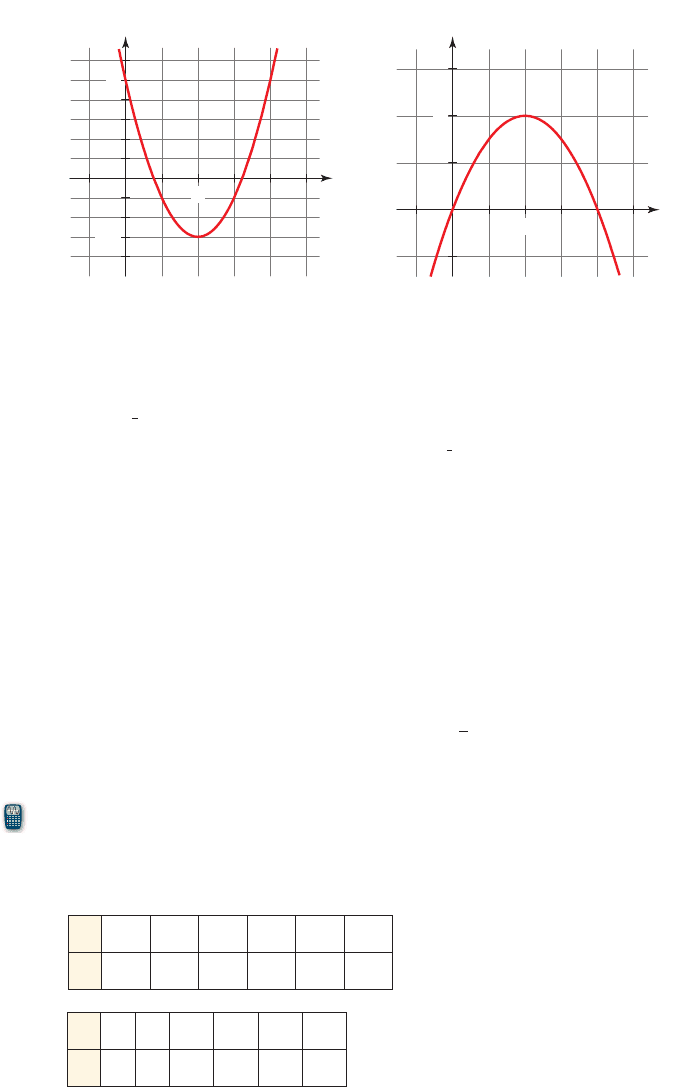
x 0.5 1.0 1.7 2.2 2.5 3.0
y 6.0 3.4 2.0 2.3 3.2 5.6
x 0 2 6 7 11 20
y 5 8 24 23 18 37
CHAPTER 5
■
Review Exercises 469
21–22 ■ Find the quadratic function whose graph is shown.
21. 22.
f 1x 2= ax
2
+ bx + c
y
x
0
5
_3
2
y
x
0
2
2
23–28 ■ Find the maximum or minimum value of the function, and find the x-coordinate
of the point at which the maximum or minimum occurs.
23. 24.
25. 26.
27. 28.
29–32
■ Solve the equation by factoring.
29. 30.
31. 32.
33–38 ■ A quadratic equation is given.
(a) Find the discriminant of the equation. How many real solutions does the equation
have?
(b) Solve the equation (if it has real solutions).
33. 34.
35. 36.
37. 38.
39–40
■ A set of data is given.
(a) Use a graphing calculator to find the quadratic model that best fits the data.
(b) Make a scatter plot of the data, and graph the function you found in part (a) on the
scatter plot. Does the model seem to fit the data well?
39.
3x
2
+ 10 = 10xx
2
+ 2x + 5 = 0
x
2
+ 212x + 2 = 04x
2
+ 1 = 4x
4x
2
- 3x - 1 = 0x
2
+ 3x - 4 = 0
3x
2
= x + 22x
2
+ 5x = 3
x
2
- 6x + 8 = 0x
2
+ 7x = 0
f 1x 2=
1
4
x
2
+ 2x - 3f 1x 2= 15x - 5x
2
f 1x 2= 2 - 6x + 3x
2
f 1x 2=-
1
3
x
2
- x + 1
f 1x 2=-2x
2
+ 10x + 65f 1x 2= x
2
+ 4x - 7
40.

470 CHAPTER 5
■
Quadratic Functions and Models
These exercises test your understanding by combining ideas from several sections in a
single problem.
41. The Form of a Quadratic Function In this chapter we have worked with three
different ways of writing the equation for a quadratic function:
■
General form:
■
Standard form:
■
Factored form:
(a) What does the number c represent in the general form?
(b) What do the numbers h and k represent in the standard form?
(c) What do the numbers m and n represent in the factored form?
(d) The graph of a quadratic function has x-intercepts 2 and 5 and y-intercept . On
the basis of the fact that you have been given the x-intercepts, which of the three
forms should you use to find the equation of the function? Use that form to find the
equation.
(e) The graph of a quadratic function has vertex and one x-intercept at 8.
Which of the three forms should you use to find the equation of the function? Use
that form to find the equation.
(f) The graph of the quadratic function f is the same as that of the function
, except that it has been shifted downward so that . Which
of the three forms should you use to find the equation of f ? Use that form to find
the equation.
(g) Find the maximum or minimum value of each of the functions you found in parts
(d), (e), and (f).
42. The Parts of a Parabola In this problem we’ll see how the vertex and the x-intercepts
of a parabola are related to each other.
(a) A parabola has the equation . Find the x-intercepts of the parabola.
(b) Find the vertex of the parabola in part (a). How is the x-coordinate of the vertex
related to the x-intercepts?
(c) Show that the relationship that you discovered in part (b) between the x-coordinate
of the vertex and the x-intercepts also holds for the parabola .
(d) If a parabola has x-intercepts 1 and 7, what must the x-coordinate of its vertex be?
Find an equation for such a parabola with y-intercept .
(e) Find an equation for the quadratic function whose graph has x-intercepts 3 and 9
and whose maximum value is 27.
43. Height of a Stone Two stones are dropped simultaneously, one from the 24th floor
and the other from the 32nd floor of a high-rise building. After t seconds, the one
dropped from the 24th floor is at a height above the ground, and the
one dropped from the 32nd floor is at a height above the ground.
(The heights are measured in feet.)
(a) Sketch graphs of and on the same coordinate axes.
(b) What transformation would you need to perform on the graph of to get the graph
of ? Express in terms of .
44. Height of a Stone (Refer to Exercise 43.) Suppose that another stone is dropped
from the 24th floor 5 seconds after the first one.
(a) What transformation would you have to perform on the function to obtain a
function
H that models the height of this new stone above the ground t seconds
after the first stone was dropped (where )?
(b) Have the first two stones already hit the ground when the last one is dropped, or is
one (or both) still in the air?
t Ú 5
h
1
h
1
h
2
h
2
h
1
h
2
h
1
h
2
1t 2= 320 - 16t
2
h
1
1t 2= 240 - 16t
2
- 3
y = x
2
+ 4x - 5
y = x
2
- 6x
f 12 2= 5g1x 2= 3x
2
+ 6x
14, - 62
- 20
f 1x2= a1x - m 21x - n 2
f 1x2= a1x - h 2
2
+ k
f 1x2= ax
2
+ bx + c
CONTEXTS
CONNECTING
THE CONCEPTS
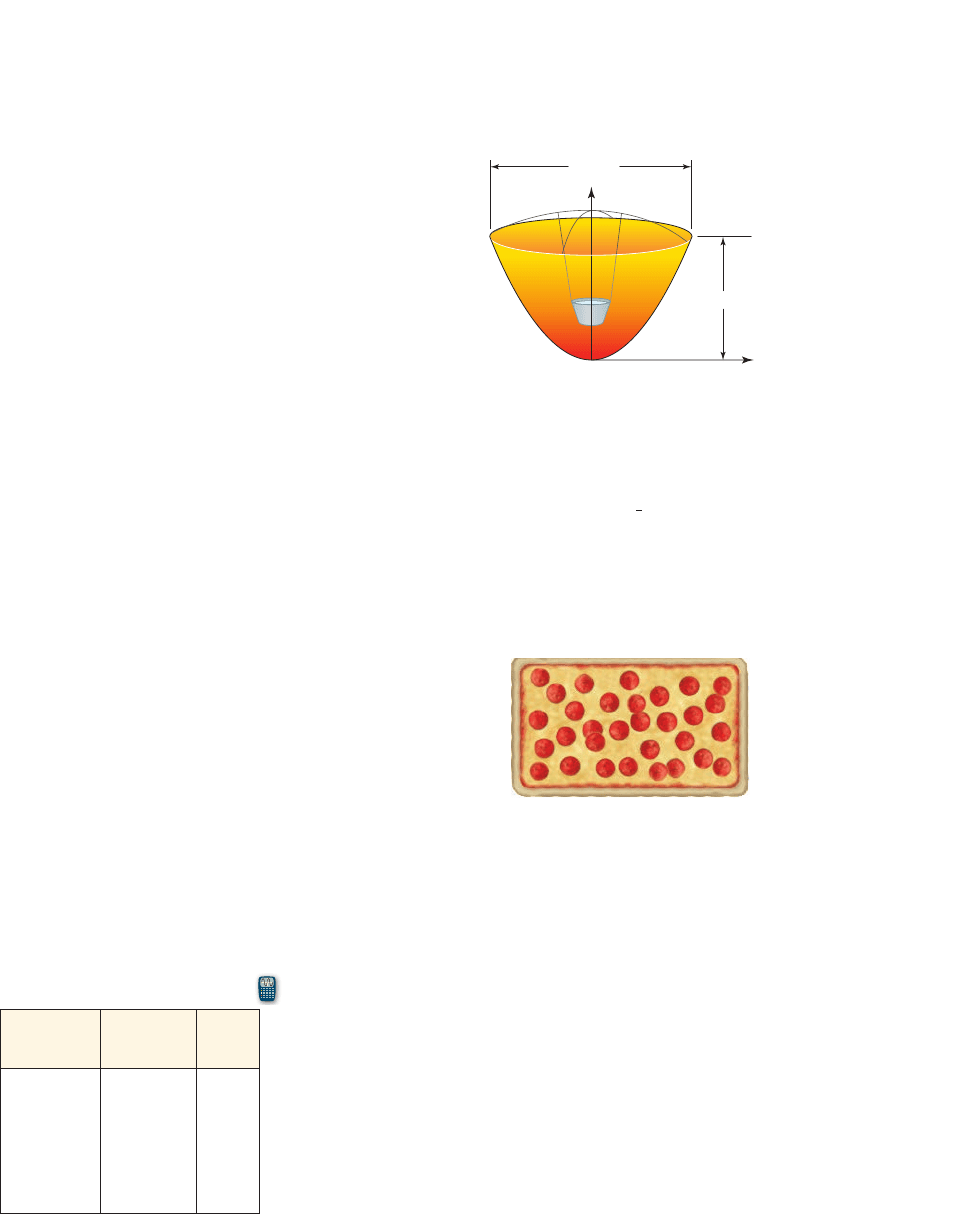
CHAPTER 5
■
Review Exercises 471
45. Parabolic Cooker Solar cookers are parabolic reflectors that concentrate the light
and heat of sunlight at one spot, where a pot of food can be placed to cook. They are
sometimes sold in camping stores and are also increasingly used in impoverished areas
of the world where cooking fuel is scarce. The figure shows a parabolic bowl-shaped
cooker in cross-section; the width is 32 inches, and the depth is 24 inches. Find a
squaring function that models the shape of the cooker.
24 in.
32
i
n.
x
y
x+3
x
Container
Fertilizer
(g)
Yield
(oz)
1 2.0 14.3
2 2.8 18.5
3 3.6 20.8
4 4.4 22.0
5 5.2 21.8
6 6.0 20.1
46. Parabolic Cooker (Refer to Exercise 45.) The width of a solar cooker determines
how much solar energy it gathers. Its depth determines how close the “hot spot” is to the
vertex: The deeper the bowl, the closer to the vertex the cooking pot can be placed. A
new variety of solar cooker has the same width, 32 inches, as the one in Exercise 45, but
its shape is modeled by the function instead. How deep is this new cooker?
47. Dimensions of a Rectangular Pizza Squarehead Pizza Parlor bakes its pizzas in the
shape of rectangles that are all 3 inches longer than they are wide.
(a) Find a function A that models the area of a pizza in terms of its width x.
(b) If a small pizza has an area of 88 square inches, what are its dimensions?
f 1x 2=
1
8
x
2
48. Maximizing Revenue Miriam sells souvenir caps to tourists in a beach town. She
observes that if she charges x dollars per cap, then she sells about caps per day. (Notice
that the higher her price, the fewer caps she sells.)
(a) Explain why her revenue per day is given by the function .
(b) What price should she charge so that her revenue is as large as possible?
49. Horticulture Experiment A student performs an experiment to determine how much
of a certain fertilizer should be applied to wheat seedlings to produce the maximum
yield. He plants wheat in six identical containers and applies different amounts of
fertilizer to each container. After the wheat reaches maturity, he harvests it and weighs
each “mini-crop.” His results are shown in the table.
(a) Use a graphing calculator to find the quadratic model that best fits the data.
(b) Draw a scatter plot of the data, together with the quadratic function you found in
part (a). Does the model seem to fit the data well?
(c) Use the model to determine how much fertilizer should be applied for the best
yield.
R1x 2= x148 - 1.6x 2
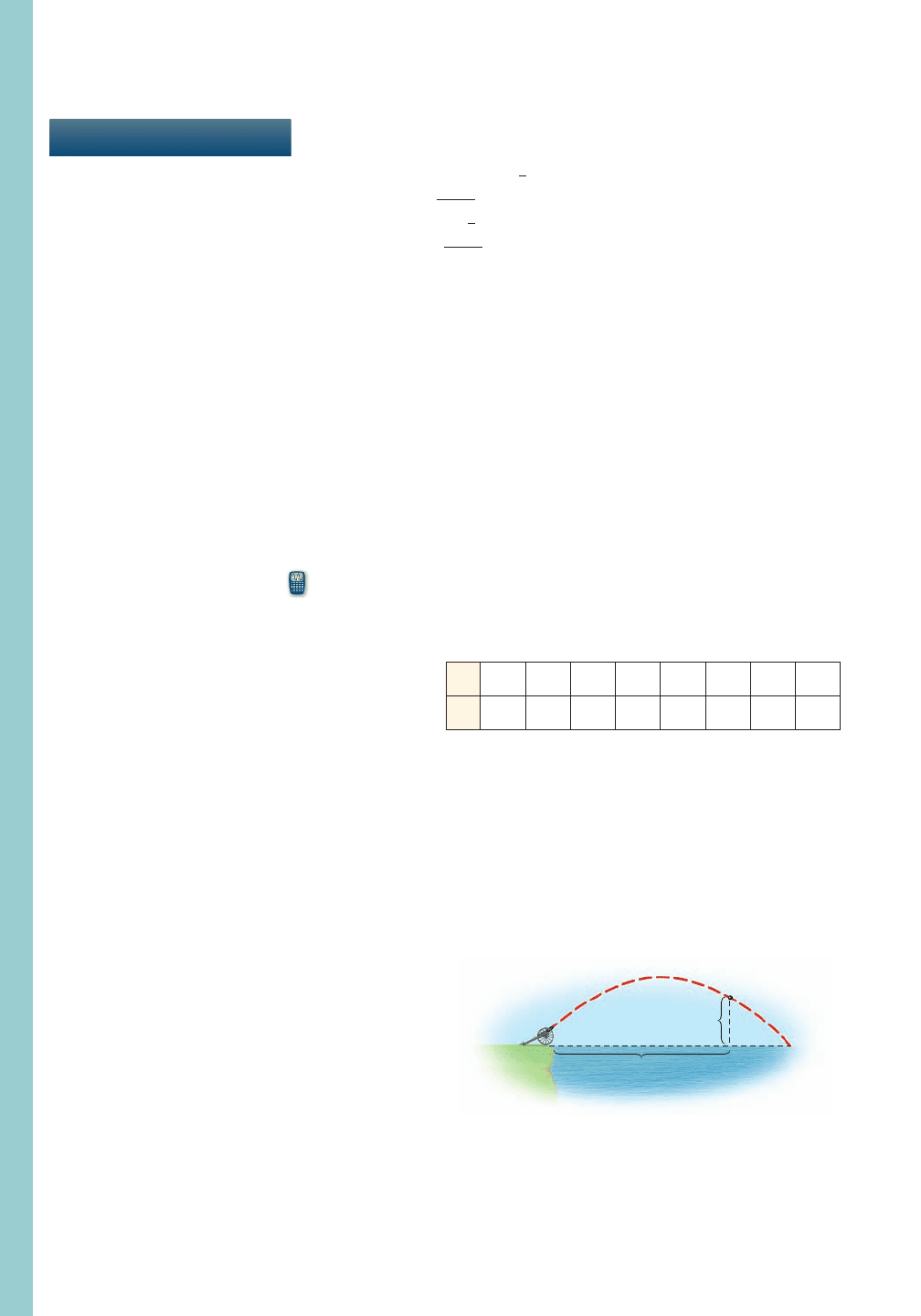
472 CHAPTER 5
■
Quadratic Functions and Models
TEST
1. Use the graph of to graph the following functions.
(a)
(b)
(c)
2. Let .
(a) Express f in the standard form of a quadratic function.
(b) What is the vertex of the graph of f ?
(c) Find the x-intercepts of the graph of f.
(d) Sketch the graph of f.
(e) Does f have a maximum or a minimum value? What is that value?
3. Find a quadratic function f whose graph has vertex and whose y-intercept is 2.
4. For each equation, use the discriminant to determine how many real solutions each
equation has, and then find all real solutions.
(a)
(b)
(c)
5. (a) Use a calculator to find the quadratic function that best models the data in the table.
(b) Make a scatter plot of the data, and graph the function you found in part (a) on the
scatter plot. Does the function seem to fit the data well?
2x
2
= 3x - 2
x
2
- 6x + 7 = 0
3x
2
+ 5x - 2 = 0
14, - 62
f 1x 2=-x
2
+ 4x + 12
k1x 2= 31x + 2
h1x 2= 2 - 1x
g1x 2= 1x - 2
f 1x 2= 1x
6. A cannonball that is fired out to sea from a shore battery follows a parabolic trajectory
given by the graph of the equation
where is the height of the cannonball above the water when it has traveled a
horizontal distance of x feet.
(a) What is the maximum height that the cannonball reaches?
(b) How far does the cannonball travel horizontally before splashing into the water?
h1x 2
h1x 2= 10x - 0.01x
2
CHAPTER
5
x 0.3 0.5 1.9 2.0 2.4 2.6 2.6 2.9
y 3.2 4.3 5.8 5.7 5.9 5.2 5.4 3.9
h(x)
x
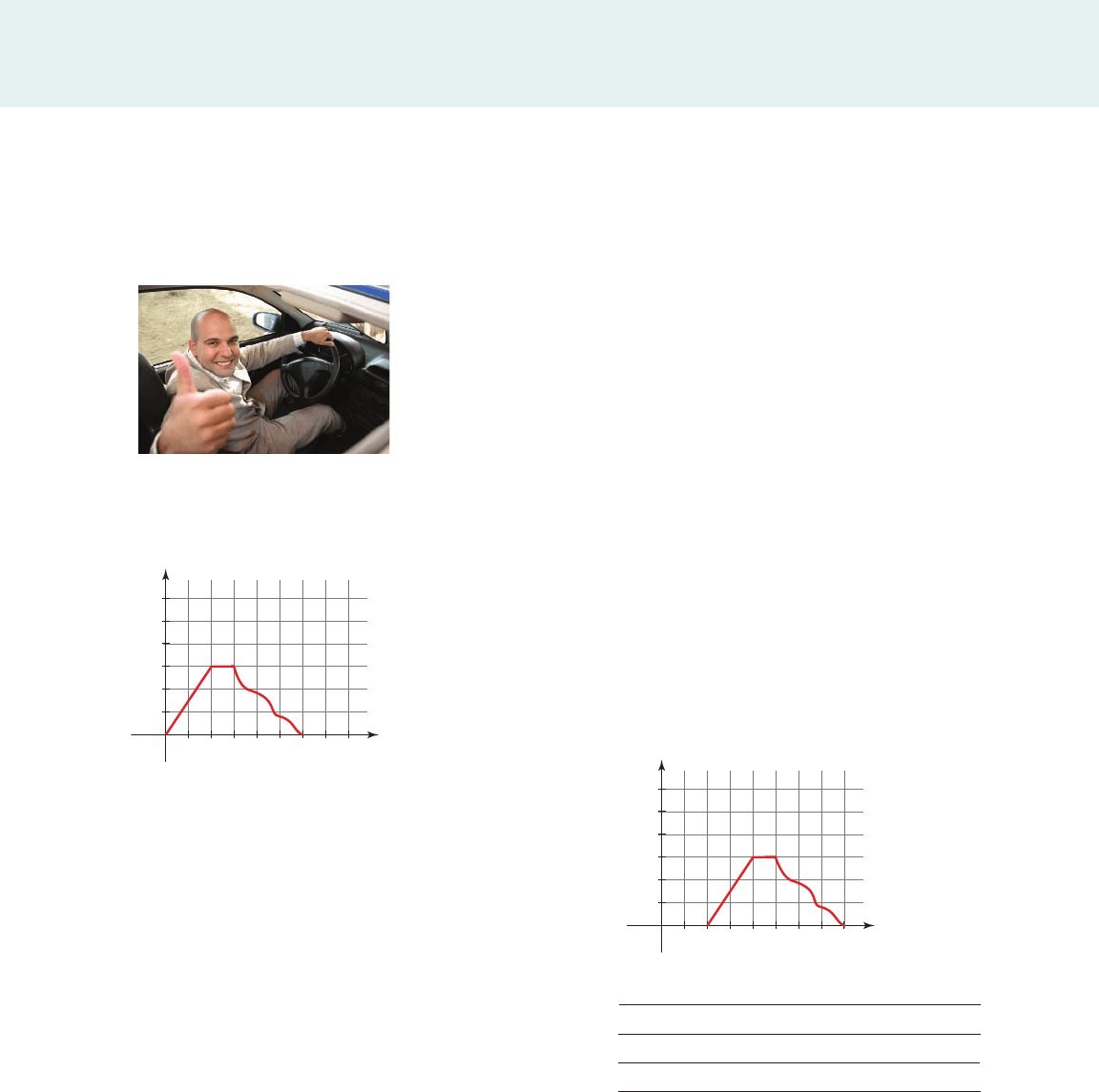
Transformation Stories
OBJECTIVE To explore the relationship between graphical, algebraic, and verbal
descriptions of transformations of functions in a real-world context.
In Exploration 3 following Chapter 1 we investigated how a graph of a real-world
situation tells a story about that situation. Now that we have studied about transfor-
mations of functions, we can use graphs to tell even more elaborate stories.
In this exploration we investigate traveling salesman Jerome’s original trip and
some of its transformations. The graph in the margin shows Jerome’s distance
in miles from his home t hours after 12:00 noon (time 0). We assume that Jerome
travels along a straight road from home to work and back.
Here is the story this graph tells about Jerome’s trip: He starts at noon and travels
at a steady speed of 30 miles per hour until 2:00 P.M. (We know this because the graph
is a straight line with slope 30.) He stops for the next hour (from 2:00 to 3:00 P.M.),
perhaps for a business meeting, at a location 60 miles from his home. He starts driv-
ing back at 3:00 P.M. and arrives home at 6:00 P.M. He travels at various speeds, but his
average speed for the trip back home is 20 miles per hour.
I. Reading a Transformation Story from a Graph
Let’s look at some graphs of transformations of Jerome’s trip. For each graph, state
what the transformation is in words, then in symbols, and then describe the story that
the graph tells about Jerome’s transformed trip.
1. The graph below gives Jerome’s distance from home at time t.A1t2
F1t 2
EXPLORATIONS
■
EXPLORATIONS
■
EXPLORATIONS
■
EXPLORATIONS
1
Traveling salesman
d (mi)
F
t (h)
0
12345678
20
40
60
80
100
120
Traveling salesman Jerome’s
original trip
Vladimir Mucibabic/Shutterstock.com
Verbal: Shift to the right 2 units
Symbolic: A(t) (t )
Story: The trip is exactly the same as the original trip,
but he started two hours later (at 2 P.M.).
ⴚ 2ⴝ F
d (mi)
t (h)
0
12345678
20
40
60
80
100
120
A
EXPLORATIONS 473
